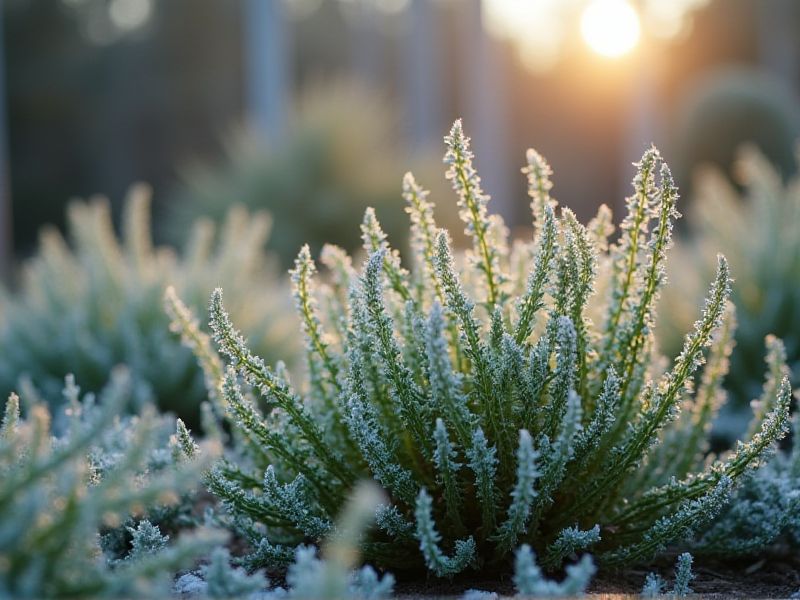
Frost-resistant winter plants thrive in cold climates, offering vibrant colors and textures even under icy conditions. Notable examples include the hellebore, known for its beautiful blooms, and the winter jasmine, which showcases bright yellow flowers. Evergreen varieties like holly and boxwood maintain their foliage, providing year-round greenery and natural structure to your landscape. Ornamental grasses, such as blue fescue, add interesting contrasts with their feathery plumes. Incorporating these hardy species into your garden can enhance beauty while ensuring resilience against harsh winter conditions.
List of some Winter plants that withstand frost
- Winter Jasmine (Jasminum nudiflorum)
- Snowdrop (Galanthus nivalis)
- Hellebore (Helleborus spp.)
- Winter Heath (Erica carnea)
- Pansy (Viola tricolor var. hortensis)
- Camellia (Camellia japonica)
- Siberian Bugloss (Brunnera macrophylla)
- Witch Hazel (Hamamelis virginiana)
- Dogwood (Cornus sericea)
- Evergreen Holly (Ilex aquifolium)
Important things about Winter plants that withstand frost
Types Of Frost-Resistant Plants
Frost-resistant plants are essential for maintaining vibrant gardens during winter, with some top choices including pansies, kale, and hellebores. These hardy specimens can thrive in low temperatures, often showcasing vibrant foliage or flowers even when frost is present. You can also consider planting established perennials like sedum and coneflower, which exhibit resilience against cold conditions. Incorporating these frost-resistant varieties ensures your outdoor space remains lively throughout the winter months, enhancing its overall appeal.
Ideal Growing Conditions
Winter plants that withstand frost thrive best in well-drained soil with a pH level between 6.0 and 7.5. An ideal planting location receives partial to full sunlight, which encourages robust growth while still offering protection from harsh winds. You should consider incorporating organic mulch to maintain soil temperature and moisture, preventing water stress during freezing conditions. Selecting hardy varieties such as pansies, kale, and hellebore can ensure vibrant winter landscapes despite the cold temperatures.
Soil Requirements
Winter plants that withstand frost typically thrive in well-draining soil enriched with organic matter, which enhances moisture retention without promoting root rot. A pH level between 6.0 and 7.0 is ideal, providing a balanced nutrient profile that supports healthy growth. Consider amending your soil with compost or aged manure to boost fertility and improve its structure, allowing for better aeration. Ensuring proper drainage is crucial, as waterlogged soil can be detrimental to the roots of frost-resistant plants like winter kale and pansies.
Maintenance Needs
Winter plants that withstand frost require specific care to thrive during the colder months. Choosing hardy varieties such as Pansies, Hellebores, and Winter Jasmine ensures vibrant color in your garden despite harsh conditions. Regular watering is essential, especially in dry spells, as frost can dehydrate plants. Mulching around the base provides insulation against extreme temperatures, promoting healthy root development and helping your plants endure winter resilience.
Watering Techniques
Winter plants that withstand frost require specific watering techniques to thrive during cold months. It's essential to water them deeply but less frequently, as this encourages strong root growth and prevents waterlogged soil, which can lead to root rot. Utilizing mulch around your plants can help retain moisture and regulate soil temperature, protecting roots from the harsh conditions. Always water in the early part of the day, allowing any excess moisture to evaporate before nighttime, reducing the risk of frost damage.
Mulching Benefits
Mulching is an essential practice for winter plants, especially those that are frost-tolerant like kale, pansies, and ornamental cabbages. Applying a layer of organic mulch, such as straw or wood chips, helps insulate the soil, maintaining a more consistent temperature that protects roots from freezing. This barrier not only reduces frost heave but also minimizes weed growth, allowing your winter plants to thrive without competition for nutrients. Furthermore, mulching enhances soil moisture retention, ensuring that your frost-resistant plants have access to the water essential for their growth during the colder months.
Pest And Disease Resistance
Winter plants such as kale, Brussels sprouts, and winter pansies exhibit remarkable frost resistance, making them ideal for cold climates. These hardy species not only endure frigid temperatures but also develop enhanced flavors and nutrients as a result of cold exposure. When selecting winter crops, consider varieties like 'Winterbor' kale and 'Long Island Improved' Brussels sprouts, known for their superior resilience against pests and diseases. To protect your garden from common winter pests, practice crop rotation and maintain healthy soil to promote robust plant growth.
Seasonal Color And Texture
Winter plants that withstand frost, such as Hellebores and Snowdrops, bring vibrant color and texture to your garden during the colder months. Hellebores, with their large, nodding flowers, bloom in various shades from soft pastels to deep purples, creating a stunning contrast against the backdrop of snow. Snowdrops, featuring delicate white flowers, are one of the earliest bloomers, often peeking through the frost with graceful resilience. Incorporating these frost-tolerant plants not only enhances the visual appeal of your landscape but also contributes to biodiversity, providing essential habitats for winter pollinators.
Companion Planting Options
Winter plants that withstand frost include kale, spinach, and Swiss chard, offering resilience against icy conditions while nurturing the soil. Companion planting these greens with garlic and onions can enhance their growth, as the aromatic compounds deter pests and improve crop yield. Planting cover crops like clover not only protects the soil but also fixes nitrogen, benefiting subsequent summer crops. Incorporating these hardy companions in your winter garden ensures a robust and sustainable ecosystem, even in harsh climates.
Hardiness Zones
Hardiness zones are essential for selecting winter plants that can withstand frost in your garden. Zones indicate the minimum temperature a plant can tolerate, helping you choose resilient species like Hellebores, often known as Christmas roses, which bloom beautifully even under snow. Other noteworthy options include Siberian Iris and Winter Aconite, both renowned for their ability to thrive in cold conditions and provide vibrant color during the dreary winter months. By understanding your specific hardiness zone, you can create an inviting landscape that remains visually appealing throughout the winter season.
